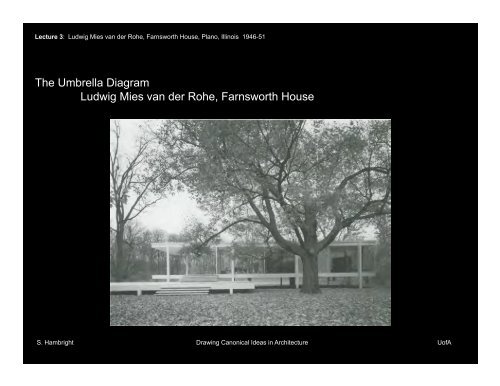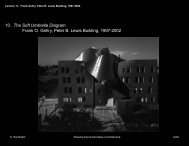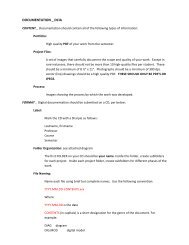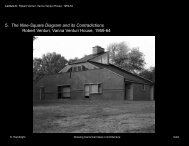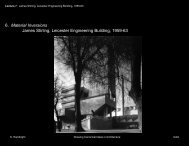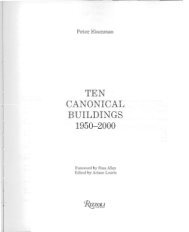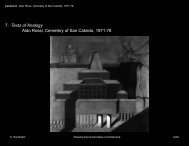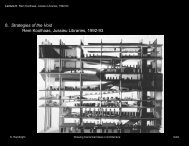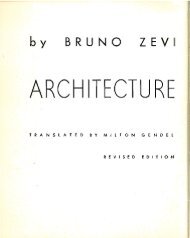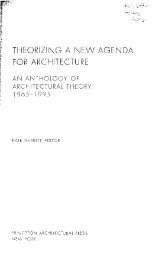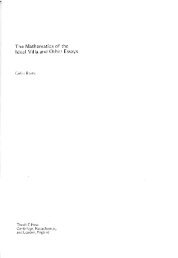The Umbrella Diagram Ludwig Mies van der Rohe, Farnsworth House
The Umbrella Diagram Ludwig Mies van der Rohe, Farnsworth House
The Umbrella Diagram Ludwig Mies van der Rohe, Farnsworth House
Create successful ePaper yourself
Turn your PDF publications into a flip-book with our unique Google optimized e-Paper software.
Lecture 3: <strong>Ludwig</strong> <strong>Mies</strong> <strong>van</strong> <strong>der</strong> <strong>Rohe</strong>, <strong>Farnsworth</strong> <strong>House</strong>, Plano, Illinois 1946-51<strong>The</strong> <strong>Umbrella</strong> <strong>Diagram</strong><strong>Ludwig</strong> <strong>Mies</strong> <strong>van</strong> <strong>der</strong> <strong>Rohe</strong>, <strong>Farnsworth</strong> <strong>House</strong>S. Hambright Drawing Canonical Ideas in Architecture UofA
Lecture 3: <strong>Ludwig</strong> <strong>Mies</strong> <strong>van</strong> <strong>der</strong> <strong>Rohe</strong>, <strong>Farnsworth</strong> <strong>House</strong>, Plano, Illinois 1946-51“Less is more” or “Less is a bore”“Roland Barthes’s citation of ‘the boring’ as a locus of resistance…”“the <strong>Farnsworth</strong> <strong>House</strong> reveals important deviations from the mo<strong>der</strong>nistconventions of the open plan and the expression of structure.”Andy WarholCampbell’s Soup Cans1962According to Barthes, how is ‘boring’ good? What does he mean by ‘locus of resistance.’S. Hambright Drawing Canonical Ideas in Architecture UofA
Lecture 3: <strong>Ludwig</strong> <strong>Mies</strong> <strong>van</strong> <strong>der</strong> <strong>Rohe</strong>, <strong>Farnsworth</strong> <strong>House</strong>, Plano, Illinois 1946-51Le Corbusier : Maison Dom-ino and the Maison Citrohan“…the <strong>Farnsworth</strong> <strong>House</strong> marks one of the beginnings of the breakdown of theclassical part-to-whole unity of the house.”S. Hambright Drawing Canonical Ideas in Architecture UofA
Lecture 3: <strong>Ludwig</strong> <strong>Mies</strong> <strong>van</strong> <strong>der</strong> <strong>Rohe</strong>, <strong>Farnsworth</strong> <strong>House</strong>, Plano, Illinois 1946-51Gerrit Rietveld: Schroe<strong>der</strong> <strong>House</strong>, Utrecht, Netherlands“…these were still single, definable entities.”S. Hambright Drawing Canonical Ideas in Architecture UofA
Lecture 3: <strong>Ludwig</strong> <strong>Mies</strong> <strong>van</strong> <strong>der</strong> <strong>Rohe</strong>, <strong>Farnsworth</strong> <strong>House</strong>, Plano, Illinois 1946-51<strong>Mies</strong> <strong>van</strong> <strong>der</strong> <strong>Rohe</strong>, Concrete Country <strong>House</strong>, 1923, Germany“…these were still single, definable entities.”S. Hambright Drawing Canonical Ideas in Architecture UofA
Lecture 3: <strong>Ludwig</strong> <strong>Mies</strong> <strong>van</strong> <strong>der</strong> <strong>Rohe</strong>, <strong>Farnsworth</strong> <strong>House</strong>, Plano, Illinois 1946-51<strong>Mies</strong> <strong>van</strong> <strong>der</strong> <strong>Rohe</strong>, Brick country <strong>House</strong>, 1924, Neubabelsberg, Germany“…these were still single, definable entities.”S. Hambright Drawing Canonical Ideas in Architecture UofA
Lecture 3: <strong>Ludwig</strong> <strong>Mies</strong> <strong>van</strong> <strong>der</strong> <strong>Rohe</strong>, <strong>Farnsworth</strong> <strong>House</strong>, Plano, Illinois 1946-51<strong>Mies</strong> <strong>van</strong> <strong>der</strong> <strong>Rohe</strong>, Hermann Lange <strong>House</strong>, 1927-30, Krefeld, Germany“…these were still single, definable entities.”S. Hambright Drawing Canonical Ideas in Architecture UofA
Lecture 3: <strong>Ludwig</strong> <strong>Mies</strong> <strong>van</strong> <strong>der</strong> <strong>Rohe</strong>, <strong>Farnsworth</strong> <strong>House</strong>, Plano, Illinois 1946-51Palazzo Farnese, 16 th Century, Rome, Italy“<strong>Mies</strong>’s rejection of the part-to-whole unity is more subtle than Walter Gropius’s andMarcel Breuer’s obvious bi-nuclear houses, which are conceptually two-thirds of aPalazzo type.”S. Hambright Drawing Canonical Ideas in Architecture UofA
Lecture 3: <strong>Ludwig</strong> <strong>Mies</strong> <strong>van</strong> <strong>der</strong> <strong>Rohe</strong>, <strong>Farnsworth</strong> <strong>House</strong>, Plano, Illinois 1946-51Marcel Breuer, Bi-nuclear <strong>House</strong>, 1943“<strong>Mies</strong>’s rejection of the part-to-whole unity is more subtle than Walter Gropius’s andMarcel Breuer’s obvious bi-nuclear houses, which are conceptually two-thirds of aPalazzo type.”S. Hambright Drawing Canonical Ideas in Architecture UofA
Lecture 3: <strong>Ludwig</strong> <strong>Mies</strong> <strong>van</strong> <strong>der</strong> <strong>Rohe</strong>, <strong>Farnsworth</strong> <strong>House</strong>, Plano, Illinois 1946-51“Heidegger’ notion of dwelling concerned the rootedness to a place: site specificity,the grounding of the subject, and ultimately the presentness of presence.”“we attain to dwelling, so it seems, only by means of building. <strong>The</strong> latter,building, has the former, dwelling, as its goal.”“dwelling and building are related as end and means.”“For <strong>Mies</strong>, dwelling is an abstract series of conditions and, in the case of the<strong>Farnsworth</strong> <strong>House</strong>, the ‘dwelling’ itself offers the opportunity to enact a criticalreading of mo<strong>der</strong>nity.”Can you discuss the two different types of ‘dwelling?’How is <strong>Mies</strong>’s idea of dwelling evident in the <strong>Farnsworth</strong> <strong>House</strong>?S. Hambright Drawing Canonical Ideas in Architecture UofA
Lecture 3: <strong>Ludwig</strong> <strong>Mies</strong> <strong>van</strong> <strong>der</strong> <strong>Rohe</strong>, <strong>Farnsworth</strong> <strong>House</strong>, Plano, Illinois 1946-51“it is a hinge between what mo<strong>der</strong>nism was in <strong>Mies</strong> and what will appear postmo<strong>der</strong>nin his work.”S. Hambright Drawing Canonical Ideas in Architecture UofA
Lecture 3: <strong>Ludwig</strong> <strong>Mies</strong> <strong>van</strong> <strong>der</strong> <strong>Rohe</strong>, <strong>Farnsworth</strong> <strong>House</strong>, Plano, Illinois 1946-51“the <strong>Farnsworth</strong> <strong>House</strong> also sets up the difference between a scenographic, orpostmo<strong>der</strong>nist, use of architecture elements to create visual illusion, and thealternative use of the column and wall to provoke a critical reading of mo<strong>der</strong>nity.”S. Hambright Drawing Canonical Ideas in Architecture UofA
Lecture 3: <strong>Ludwig</strong> <strong>Mies</strong> <strong>van</strong> <strong>der</strong> <strong>Rohe</strong>, <strong>Farnsworth</strong> <strong>House</strong>, Plano, Illinois 1946-51<strong>Mies</strong> <strong>van</strong> <strong>der</strong> <strong>Rohe</strong>, Brick country <strong>House</strong>, 1924, Neubabelsberg, Germany“…used vertical walls extending and pinwheeling out from a central vortex.’”S. Hambright Drawing Canonical Ideas in Architecture UofA
Lecture 3: <strong>Ludwig</strong> <strong>Mies</strong> <strong>van</strong> <strong>der</strong> <strong>Rohe</strong>, <strong>Farnsworth</strong> <strong>House</strong>, Plano, Illinois 1946-51<strong>Mies</strong> <strong>van</strong> <strong>der</strong> <strong>Rohe</strong>, Tugendhat <strong>House</strong>, 1928-30, Brno, Czechoslovakia“…were composed of vertical planes which no longer extended out from the mainvolume, but rather defined and enclosed space.’”S. Hambright Drawing Canonical Ideas in Architecture UofA
Lecture 3: <strong>Ludwig</strong> <strong>Mies</strong> <strong>van</strong> <strong>der</strong> <strong>Rohe</strong>, <strong>Farnsworth</strong> <strong>House</strong>, Plano, Illinois 1946-51<strong>Mies</strong> <strong>van</strong> <strong>der</strong> <strong>Rohe</strong>, Court <strong>House</strong>s,1930’s“…were composed of vertical planes which no longer extended out from the mainvolume, but rather defined and enclosed space.’”S. Hambright Drawing Canonical Ideas in Architecture UofA
Lecture 3: <strong>Ludwig</strong> <strong>Mies</strong> <strong>van</strong> <strong>der</strong> <strong>Rohe</strong>, <strong>Farnsworth</strong> <strong>House</strong>, Plano, Illinois 1946-51<strong>Mies</strong> <strong>van</strong> <strong>der</strong> <strong>Rohe</strong>, German Pavilion, 1928-29, Barcelona, Spain“<strong>The</strong> walls here are no longer load-bearing, rather the columns become the loadbearingelements; the enclosing elements are distinguished from the tectonicelements.”S. Hambright Drawing Canonical Ideas in Architecture UofA
Lecture 3: <strong>Ludwig</strong> <strong>Mies</strong> <strong>van</strong> <strong>der</strong> <strong>Rohe</strong>, <strong>Farnsworth</strong> <strong>House</strong>, Plano, Illinois 1946-51Free Plan, Le CorbusierRaumplan, Adolf LoosDiscuss the difference between Raumplan, free plan, and open plan.“<strong>The</strong> pavilion could be called an open plan, as opposed to a Raumplan or even afree plan…which allowed for a free movement of enclosing walls.”S. Hambright Drawing Canonical Ideas in Architecture UofA
Lecture 3: <strong>Ludwig</strong> <strong>Mies</strong> <strong>van</strong> <strong>der</strong> <strong>Rohe</strong>, <strong>Farnsworth</strong> <strong>House</strong>, Plano, Illinois 1946-51Adolf Loos, Villa Muller, 1930Prague, Czech RepublicS. Hambright Drawing Canonical Ideas in Architecture UofA
Lecture 3: <strong>Ludwig</strong> <strong>Mies</strong> <strong>van</strong> <strong>der</strong> <strong>Rohe</strong>, <strong>Farnsworth</strong> <strong>House</strong>, Plano, Illinois 1946-51VitruviusCommodity = usefulnessFirmness = structural utilityDelight = beautyC.S. Pierce’s categories of signsIcon – visual and formal similitudeSymbol – cultural meaningIndex – prior activityHow do these two categorizations apply to architectural elements?Columns, Roofs, Plinths, etc?“Alberti said that all architecture is firmitas because all architecture must stand up,and suggests that Vitruvius was stressing firmitas not in reference to standing up, butIn reference to the appearance of standing up – in other words, as the sign of structure.”S. Hambright Drawing Canonical Ideas in Architecture UofA
Lecture 3: <strong>Ludwig</strong> <strong>Mies</strong> <strong>van</strong> <strong>der</strong> <strong>Rohe</strong>, <strong>Farnsworth</strong> <strong>House</strong>, Plano, Illinois 1946-51Discuss the difference between the Maison Dom-ino and the <strong>Farnsworth</strong> <strong>House</strong> diagrams in terms of columns.S. Hambright Drawing Canonical Ideas in Architecture UofA
Lecture 3: <strong>Ludwig</strong> <strong>Mies</strong> <strong>van</strong> <strong>der</strong> <strong>Rohe</strong>, <strong>Farnsworth</strong> <strong>House</strong>, Plano, Illinois 1946-51Le Corbusier, Villa Savoy, 1929, Poissy, France“…the column was a didactic mark that punctuated space in the free plan. Usuallythese punctuations were round, allowing space to flow freely around them.”S. Hambright Drawing Canonical Ideas in Architecture UofA
Lecture 3: <strong>Ludwig</strong> <strong>Mies</strong> <strong>van</strong> <strong>der</strong> <strong>Rohe</strong>, <strong>Farnsworth</strong> <strong>House</strong>, Plano, Illinois 1946-51Le Corbusier, Villa Savoy, 1929, Poissy, FranceS. Hambright Drawing Canonical Ideas in Architecture UofA
Lecture 3: <strong>Ludwig</strong> <strong>Mies</strong> <strong>van</strong> <strong>der</strong> <strong>Rohe</strong>, <strong>Farnsworth</strong> <strong>House</strong>, Plano, Illinois 1946-51<strong>Mies</strong> <strong>van</strong> <strong>der</strong> <strong>Rohe</strong>, German Pavilion, 1928-29, Barcelona, Spain“Another theoretical proposition resides in the problematic of thecorner...the play of solid, void, and edge are simultaneousconditions.”S. Hambright Drawing Canonical Ideas in Architecture UofA
Lecture 3: <strong>Ludwig</strong> <strong>Mies</strong> <strong>van</strong> <strong>der</strong> <strong>Rohe</strong>, <strong>Farnsworth</strong> <strong>House</strong>, Plano, Illinois 1946-51<strong>Mies</strong> <strong>van</strong> <strong>der</strong> <strong>Rohe</strong>, Crown Hall and IIT Campus, 1950-56 and1939-41, Chicago, Illinois“Another theoretical proposition resides in the problematic of the corner...the playof solid, void, and edge are simultaneous conditions.”S. Hambright Drawing Canonical Ideas in Architecture UofA
Lecture 3: <strong>Ludwig</strong> <strong>Mies</strong> <strong>van</strong> <strong>der</strong> <strong>Rohe</strong>, <strong>Farnsworth</strong> <strong>House</strong>, Plano, Illinois 1946-51<strong>Farnsworth</strong> <strong>House</strong>How is the use of columns different in the <strong>Farnsworth</strong> <strong>House</strong>?How is this an umbrella diagram? What does Eisenman mean by umbrella diagram?“…the columns are no longer at the corner, neither gridding space internally norholding the outboard corners.”S. Hambright Drawing Canonical Ideas in Architecture UofA
Lecture 3: <strong>Ludwig</strong> <strong>Mies</strong> <strong>van</strong> <strong>der</strong> <strong>Rohe</strong>, <strong>Farnsworth</strong> <strong>House</strong>, Plano, Illinois 1946-51Why does Eisenman think a comparison to LeCorbusier’s Maison Dom-ino and Philip Johnson’s Glass<strong>House</strong> is superficial?Philip Johnson, Glass <strong>House</strong>, 1949, New Canaan, Connecticut“<strong>The</strong> <strong>Farnsworth</strong> <strong>House</strong> is not about trabeation, but rather engages the look oftrabeation in bringing the columns outboard and suspending the floor and roof slabsbetween the columns.”S. Hambright Drawing Canonical Ideas in Architecture UofA
Lecture 3: <strong>Ludwig</strong> <strong>Mies</strong> <strong>van</strong> <strong>der</strong> <strong>Rohe</strong>, <strong>Farnsworth</strong> <strong>House</strong>, Plano, Illinois 1946-51How do the columns in the <strong>Farnsworth</strong> <strong>House</strong> read as‘structure ‘ and as a ‘sign.’<strong>Farnsworth</strong> <strong>House</strong>“Instead the column reads as both structure and the sign of its diagrammaticcondition.”S. Hambright Drawing Canonical Ideas in Architecture UofA
Lecture 3: <strong>Ludwig</strong> <strong>Mies</strong> <strong>van</strong> <strong>der</strong> <strong>Rohe</strong>, <strong>Farnsworth</strong> <strong>House</strong>, Plano, Illinois 1946-51What does Eisenman mean by the‘mask of structure?’<strong>Mies</strong> <strong>van</strong> <strong>der</strong> <strong>Rohe</strong>, Seagram Building,1957, New York, New York“This thematic in <strong>Mies</strong>’s postwar work engages structure that is the sign of structure;what is seen is not the actual column, but a mask of the structure.”S. Hambright Drawing Canonical Ideas in Architecture UofA
Lecture 3: <strong>Ludwig</strong> <strong>Mies</strong> <strong>van</strong> <strong>der</strong> <strong>Rohe</strong>, <strong>Farnsworth</strong> <strong>House</strong>, Plano, Illinois 1946-51<strong>Mies</strong> <strong>van</strong> <strong>der</strong> <strong>Rohe</strong>, S.R. Crown Hall,1950-56, Chicago, IllinoisWhat does Eisenman mean by the ‘mask of structure?’S. Hambright Drawing Canonical Ideas in Architecture UofA
Lecture 3: <strong>Ludwig</strong> <strong>Mies</strong> <strong>van</strong> <strong>der</strong> <strong>Rohe</strong>, <strong>Farnsworth</strong> <strong>House</strong>, Plano, Illinois 1946-51Le Corbusier ‘s Maison Dom-inoDiscuss the differences of the plinths and roofplanes in these two buildings.<strong>Farnsworth</strong> <strong>House</strong>“<strong>The</strong> plinth and the horizontal roof plane are again conceptually different in <strong>Mies</strong>’sspace as opposed to Le Corbusier’s space.”S. Hambright Drawing Canonical Ideas in Architecture UofA
Lecture 3: <strong>Ludwig</strong> <strong>Mies</strong> <strong>van</strong> <strong>der</strong> <strong>Rohe</strong>, <strong>Farnsworth</strong> <strong>House</strong>, Plano, Illinois 1946-51<strong>Mies</strong> <strong>van</strong> <strong>der</strong> <strong>Rohe</strong>, Resor <strong>House</strong>, 1937-38, Jackson Hole, Wyoming“<strong>The</strong> house seems to float above the ground, though it actually spans a ravine and isanchored at both ends.”S. Hambright Drawing Canonical Ideas in Architecture UofA
Lecture 3: <strong>Ludwig</strong> <strong>Mies</strong> <strong>van</strong> <strong>der</strong> <strong>Rohe</strong>, <strong>Farnsworth</strong> <strong>House</strong>, Plano, Illinois 1946-51Le Corbusier ‘s Maison Dom-inoHow does Corbusier’s plinth signal the infinitehorizontal extension of space?How does <strong>Mies</strong>’s plinth set out the ultimatedistinction between ground and roof?<strong>Farnsworth</strong> <strong>House</strong>“This lifting of the house has a different value than Le Corbusier’s Dom-ino diagram.For Le Corbusier it signals the infinite horizontal extension of space; for <strong>Mies</strong>, it setsout the ultimate distinction between ground and the roof...”S. Hambright Drawing Canonical Ideas in Architecture UofA
Lecture 3: <strong>Ludwig</strong> <strong>Mies</strong> <strong>van</strong> <strong>der</strong> <strong>Rohe</strong>, <strong>Farnsworth</strong> <strong>House</strong>, Plano, Illinois 1946-51<strong>Farnsworth</strong> <strong>House</strong><strong>Mies</strong> <strong>van</strong> <strong>der</strong> <strong>Rohe</strong>, 50 X 50 <strong>House</strong>, 1950-52What are the implications for the 50 X 50 <strong>House</strong> that came from the <strong>Farnsworth</strong> <strong>House</strong>?Do you see any implications from other previous projects?“<strong>The</strong> <strong>Farnsworth</strong> <strong>House</strong> also had important implications for the 50 X 50 <strong>House</strong>...”S. Hambright Drawing Canonical Ideas in Architecture UofA
Lecture 3: <strong>Ludwig</strong> <strong>Mies</strong> <strong>van</strong> <strong>der</strong> <strong>Rohe</strong>, <strong>Farnsworth</strong> <strong>House</strong>, Plano, Illinois 1946-51Describe the umbrelladiagram at Crown Hall.<strong>Mies</strong> <strong>van</strong> <strong>der</strong> <strong>Rohe</strong>, S.R. Crown Hall,1950-56, Chicago, Illinois“Together, the roof line and single columns produce an image of an umbrella-likestructure. What follows, less literally but no less conceptually...”S. Hambright Drawing Canonical Ideas in Architecture UofA
Lecture 3: <strong>Ludwig</strong> <strong>Mies</strong> <strong>van</strong> <strong>der</strong> <strong>Rohe</strong>, <strong>Farnsworth</strong> <strong>House</strong>, Plano, Illinois 1946-51<strong>Mies</strong> <strong>van</strong> <strong>der</strong> <strong>Rohe</strong>, National Gallery, 1962-68,Berlin, GermanyExplain how the diagram is finally concept and not image in the National Gallery.“…the umbrella effect is finally presented as concept and not image.”S. Hambright Drawing Canonical Ideas in Architecture UofA
Lecture 3: <strong>Ludwig</strong> <strong>Mies</strong> <strong>van</strong> <strong>der</strong> <strong>Rohe</strong>, <strong>Farnsworth</strong> <strong>House</strong>, Plano, Illinois 1946-51<strong>Mies</strong> <strong>van</strong> <strong>der</strong> <strong>Rohe</strong>, S.R. Crown Hall,1950-56,Chicago, Illinois<strong>Mies</strong> <strong>van</strong> <strong>der</strong> <strong>Rohe</strong>, National Gallery, 1962-68,Berlin, GermanyWhy does Eisenman say use is not what is at stake? What do you think , and why?“<strong>The</strong> idea of dwelling, or use, is clearly not what is at stake...”S. Hambright Drawing Canonical Ideas in Architecture UofA
Lecture 3: <strong>Ludwig</strong> <strong>Mies</strong> <strong>van</strong> <strong>der</strong> <strong>Rohe</strong>, <strong>Farnsworth</strong> <strong>House</strong>, Plano, Illinois 1946-51<strong>Farnsworth</strong> <strong>House</strong>Why does Eisenman think the <strong>Farnsworth</strong> <strong>House</strong>is not about the scenographic condition?What do you think about his argument?“…it becomes clear that a scenographic condition between the viewer and the buildingis not what is desired.”S. Hambright Drawing Canonical Ideas in Architecture UofA
Lecture 3: <strong>Ludwig</strong> <strong>Mies</strong> <strong>van</strong> <strong>der</strong> <strong>Rohe</strong>, <strong>Farnsworth</strong> <strong>House</strong>, Plano, Illinois 1946-51How is the bottom statement made evident by thedrawing at the right?“<strong>The</strong> different axes formed by a series of symmetrical parts indicate that the parts donot create a whole. What seems to be a classical and symmetrical whole is ratherbroken down into asymmetrical dynamic parts.”S. Hambright Drawing Canonical Ideas in Architecture UofA
Lecture 3: <strong>Ludwig</strong> <strong>Mies</strong> <strong>van</strong> <strong>der</strong> <strong>Rohe</strong>, <strong>Farnsworth</strong> <strong>House</strong>, Plano, Illinois 1946-51Philip Johnson, Glass <strong>House</strong>, 1949, New Canaan, Connecticut<strong>Farnsworth</strong> <strong>House</strong>Explain how the statement below is manifest in the images above?“Johnson’s intent is to ren<strong>der</strong> the surface as a vertical plane, while at the <strong>Farnsworth</strong><strong>House</strong>, <strong>Mies</strong> ren<strong>der</strong>s it as absence.”S. Hambright Drawing Canonical Ideas in Architecture UofA
Lecture 3: <strong>Ludwig</strong> <strong>Mies</strong> <strong>van</strong> <strong>der</strong> <strong>Rohe</strong>, <strong>Farnsworth</strong> <strong>House</strong>, Plano, Illinois 1946-51How is a scenographic representation linked to postmo<strong>der</strong>nism different from a criticalreading of mo<strong>der</strong>nity’s idea of a spatial continuum?In what way can the Glass <strong>House</strong> be read as a scenographic representation linked topostmo<strong>der</strong>nism?And, in what way is the <strong>Farnsworth</strong> <strong>House</strong> the latter?“…columns read not for their tectonic truthfulness, or fortheir visual composition, but for their condition as a signof a conceptual diagram.”S. Hambright Drawing Canonical Ideas in Architecture UofA
Lecture 3: <strong>Ludwig</strong> <strong>Mies</strong> <strong>van</strong> <strong>der</strong> <strong>Rohe</strong>, <strong>Farnsworth</strong> <strong>House</strong>, Plano, Illinois 1946-51Le Corbusier ‘s Maison Dom-ino and Citrohan<strong>Farnsworth</strong> <strong>House</strong>What are these three drawings about?S. Hambright Drawing Canonical Ideas in Architecture UofA
Lecture 3: <strong>Ludwig</strong> <strong>Mies</strong> <strong>van</strong> <strong>der</strong> <strong>Rohe</strong>, <strong>Farnsworth</strong> <strong>House</strong>, Plano, Illinois 1946-51Why do you think the corner is designed thisway?S. Hambright Drawing Canonical Ideas in Architecture UofA
Lecture 3: <strong>Ludwig</strong> <strong>Mies</strong> <strong>van</strong> <strong>der</strong> <strong>Rohe</strong>, <strong>Farnsworth</strong> <strong>House</strong>, Plano, Illinois 1946-51What are the implications for these alternativedesigns for the columns?Do you think it would have made a difference isthe reading of the building and why?S. Hambright Drawing Canonical Ideas in Architecture UofA
Lecture 3: <strong>Ludwig</strong> <strong>Mies</strong> <strong>van</strong> <strong>der</strong> <strong>Rohe</strong>, <strong>Farnsworth</strong> <strong>House</strong>, Plano, Illinois 1946-51Do you think this building was able to break from the classical part-to-whole relationship that Eisenman says persistedthroughout previous history?S. Hambright Drawing Canonical Ideas in Architecture UofA


